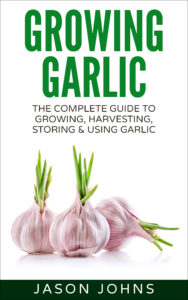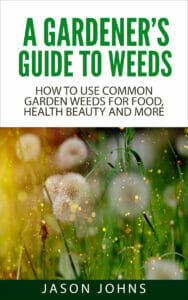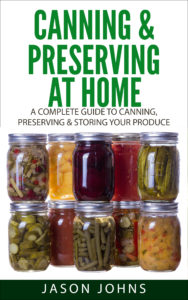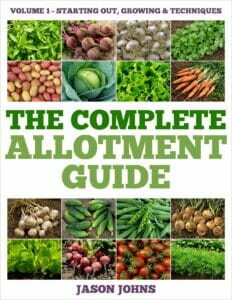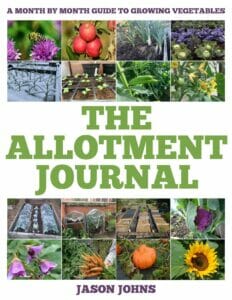Garlic, Allium sativum, is a perennial plant that is grown as an annual for its bulbs. If the bulbs are left in place, the plant will slowly spread while the bulbs grow and flower each year. A member of the onion family, garlic is very popular for its culinary use and health benefits. The cloves are best planted in the autumn before the frosts as they need cold for the bulbs to split and develop properly. Garlic cloves are best bought from a supplier rather than planting supermarket bought garlic. Garlic from the supermarket can occasionally carry diseases and may not be suitable for growing in the British climate, but many people plant this garlic anyway and get a harvest.

At a Glance Facts

History and Facts
Garlic has a long and varied history with humans where it is been a divine offering and despaired as something fit only for pigs to eat. For over 5,000 years it has been used as medicine, food, money, in magic potions and as an aphrodisiac.
Garlic is one of the oldest cultivated plants and it was grown by the Egyptians, Babylonians and possibly even by their predecessors. The Egyptians worshipped garlic as a god, and it was even used as a currency. Clay garlic bulbs have been found in ancient Egyptian tombs where they are thought to have been left as a form of money for the afterlife or as offerings to the gods.
As well as this, garlic was so valued, it was used to pay the workers who would stop working if there was a shortage of garlic. There have only been two Egyptian slave revolts that we know of, and one of them was caused when the Nile flooded and ruined the garlic crop!
While the workers loved their garlic, the upper echelons of Egyptian society shunned this pungent plant, thinking it was too coarse and would upset their delicate constitutions. The Greeks had a similar outlook on garlic with the template of Cybele having a garlic breath test, refusing entry to anyone who had eaten garlic. The ancient Indian cultures were the same, the upper classes did not eat garlic because it had a strong smell and was associated with commoners. Knights in the court of King Alfonso de Castille were also banished from polite society for a week after eating garlic.
In England, having garlic breath was considered to be unseemly for refined young ladies and gentlemen. The American culture adopted the same attitude to the point where they didn’t embrace garlic until the 1940s. Until then, it was considered an ethnic culinary ingredient and known by several slang terms, many of which were derogatory such as ‘Italian perfume’.
It is believed that garlic originated in central Southern Asia or even southwestern Siberia. The exact origin is still not precisely known, but thousands of years ago it was distributed over the known world and people grew to love it.
The modern name ‘garlic’ derives from an Anglo-Saxon word, ‘garleac’, which meant “spear leek”. It is believed that cultivated garlic is descended from a wild strain of Asian garlic, Allium longicuspis. Botanically, garlic is in the lily (Liliaceae) family and is closely related to onions, chives, shallots, and leeks.
Garlic is a massive worldwide industry as demand has skyrocketed since the 1990s. There are over 30,000,000 tonnes of garlic produced every year, with China producing around two-thirds of this. The majority of garlic is produced in Asia with a tiny amount grown in the Americas and Europe, much of which is aimed at home-growers and niche markets.
Choosing Your Garlic
When it comes to choosing garlic, you may think it is as simple as picking up some garlic and planting it, but it can be a little bit more complicated than this if you want to make the most out of your garlic crop.

There are two main types of garlic:
- Hardneck
- Softneck
On top of this, you have elephant garlic, which produces much larger cloves that are generally milder in flavour.
Hardneck garlic is more closely related to wild garlic and typically produces bulbs with fewer cloves, but they are larger. Hardneck garlic has a stronger flavour than softneck garlic and the flavour is much more interesting. Hardneck garlic does not store as well as softneck and will typically only store until the middle of winter. It is also more prone to bolting (producing a flower stalk) which does impact the ability to store the bulb. Hardneck garlic is also much hardier than softneck garlic, meaning it is better suited for cooler areas of the country.
Softneck garlic produces smaller, more tightly packed cloves that will store for much longer. When planted in springtime, softneck garlic will generally store until the following spring. It is less likely to bolt and generally only bolts if the growing conditions are poor. In colder areas, cover softneck garlic with fleece or cloches to protect them during the coldest months. The flavour of softneck garlic is generally milder than hardneck garlic.
Which you choose to grow is entirely a personal decision and depends on the climate you live in and how strong you like your garlic. If you live in the northern part of the country, then hardneck garlic is a better option because it is hardier and better suited to the climate. If you live in a warmer area, then softneck garlic is an option because it does not like it when the temperature drops too low.
Sowing and Planting
Garlic needs a good one or two months of cold, typically 0-10C/32-50F for the bulbs to split properly. This is why garlic is normally planted in late autumn or early winter. You can get away with planting garlic in January, depending on the cultivar, but it may not form cloves properly. Traditionally, garlic was planted on the shortest day and harvested on the longest, but with the shift in the climate and run-up to Christmas, most people plant garlic in November or early December.
If your soil is heavy and gets wet in winter, start garlic off in modules in a coldframe and plant it out in spring when the ground dries out.
Before planting, dig in some well-rotted manure or compost to improve the soil and dig in some general-purpose fertiliser.
Garlic cloves are planted with the tips about 1”/2.5cm below the surface and 6”/15cm between plants. Leave 12”/30cm between rows. Elephant garlic needs to be planted a little differently. Put the cloves 4-6” deep and 8-12” between bulbs as this variety grows into a much larger plant.

Plant Care
Garlic, like most alliums, does not like competition, so keep your garlic bed free from weeds. It is best to weed by hand as it is very easy to accidentally damage garlic bulbs if you use a hoe. Ensure the garlic has full sun and is not shaded by any other plants.
Unless the winter is very dry, you will not need to water your garlic, but in the spring, as the temperature warms, water the garlic and give it a good feed to perk it up after the winter. Continuing watering as necessary to encourage larger bulbs but stop watering a couple of weeks before you are due to harvest the crop. Avoid overwatering, particularly as the bulbs swell to avoid rot.
From late May, garlic starts to flower, producing long flower stems, known as scapes, from the middle of the leaves. As soon as you see these, pinch them out from the base. These scapes are a delicacy and are great in stir-fries and similar dishes to give a mild garlic flavour.
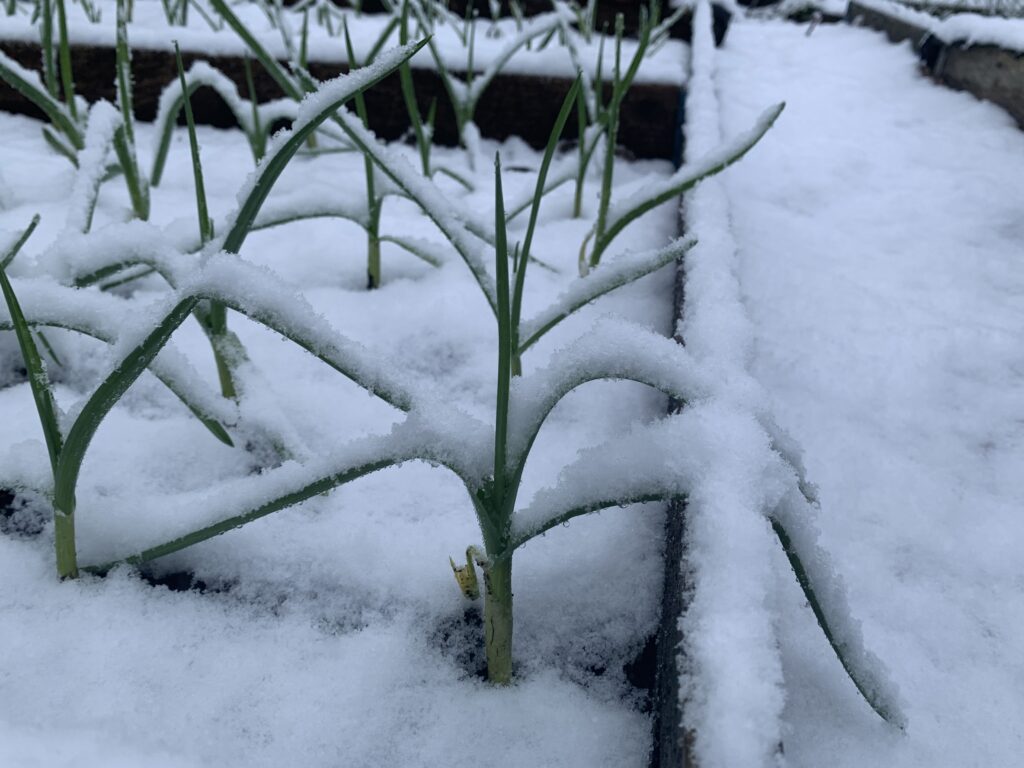
Pests and Problems
Garlic is a generally easy crop to grow and with the correct spacing, watering and feeding, will grow without a problem. However, there are some potential problems you may encounter, depending on where in the world you are growing.
Bulb Mites – several different types of bulb mites affect members of the Allium family, including garlic. One of the most common problems is dry bulb mites. These are very small mites, about 0.3mm long and look like curled worms. Their life cycle is only a couple of weeks, so they can appear at any time in the growing season. The mites overwinter in stored cloves or in the ground with autumn planted garlic. Plants infected with mites will appear stunted, but the bulbs are still edible. Bulb mites are resistant to chemical pesticides and so need to be managed with cultural, predatory and organic pest control methods. Rotating your garlic crops between beds will help reduce the incidence of bulb mites. Rove beetles, Dalotia coriaria, are a good predatory control. Neem oil can be used as an effective organic pest control.
Allium leaf miners, Phytomyza gymnostoma, are small, yellow and black flies that lay small, curled white eggs on the undersides of leaves. The eggs hatch into 8mm long larvae that tunnel into the leaves and eating down into the bulb, causing significant damage. Eventually, they turn into 3-5mm long pupae. Look for holes and curving squiggles on the leaves. Leaf miners are a major issue for all Allium crops. If they are in your local area, then cover all members of the onion family with very fine mesh floating row covers as soon as you plant your garlic as the flies look for Alliums to overwinter in. Keep the area around your garlic weed free to reduce the risk of leaf miners. Remove and destroy any infected crops. In warm weather, leaf miners can complete their lifecycle in as little as two weeks, making them a very prolific pest. Female parasitic wasps, Diglyphus isaea, are a good predator again leaf miners and can be bought online. An insecticide made from spinosad is a good control.
Onion maggots, Delia antiqua, are another potential problem as the newly hatched larvae will severely damage your onion crop. The adult flies hatch in the spring and can travel up to a mile looking for a crop to lay their eggs on. This pest is temperature sensitive, and the eggs will die when the top inch of soil reaches a temperature of 95F. When the larvae hatch, they start eating the roots. A four-year crop rotation plan helps to control onion maggots. Covering your crop with a floating row cover as soon as you plant it will help prevent the flies from finding your crop. Using diatomaceous earth can help control this pest as can several predatory insects such as rove beetles, and certain nematodes. A spinosad based spray is effective against this pest.
Onion white rot is a soil-borne fungus that is a major problem for all members of the onion family. It causes the leaves to wilt and turn yellow as the roots rot. The bulb develops a fluffy, white fungus and small, round black structures growing on it. There is no cure for onion white rot, and it is usually introduced through diseased bulbs. Lift and destroy all infected crops and do not grow any member of the onion family in the same area for 15 years.
Leek rust is another fungal disease that causes yellow spots to form on the leaves. This disease is worse in long, wet spells, but doesn’t harm the plant. In serious infection, is can cause the leaves to shrivel which does affect the size of the bulb. There is no cure for leek rust, but getting your planting spacing correct helps reduce the risk of infection significantly. Destroy any infected plant material and do not grow any member of the onion family in the same area for three years.
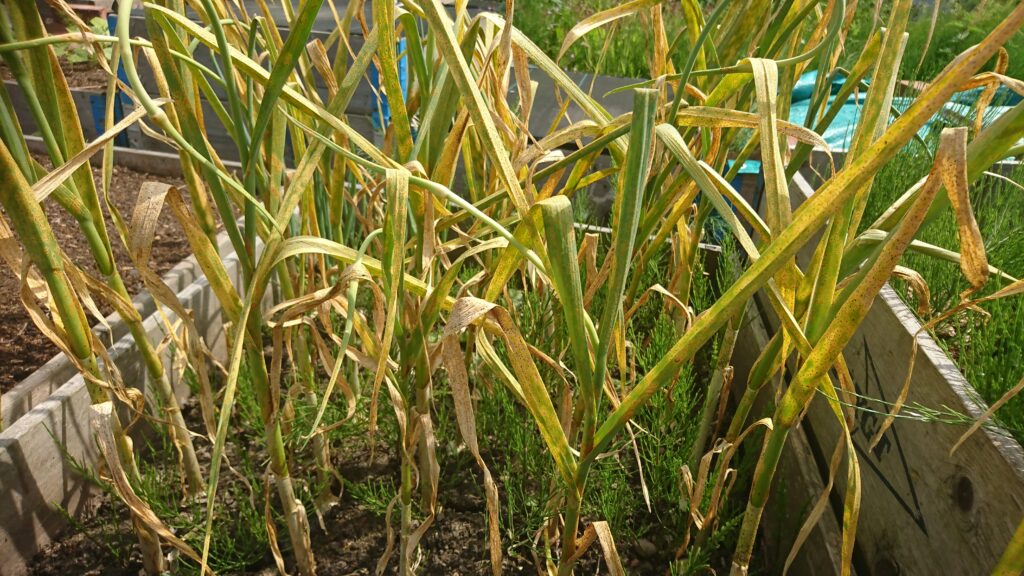
Harvesting and Storage
Garlic needs a good period of cold for it to split and form cloves. If it doesn’t get enough cold, it produces single bulbs, which are a giant garlic clove. These can be used as is or they can be kept and replanted the following year.
The plants are ready to be harvested when the leaves start to yellow and wilt. However, if you need garlic urgently, you can pull a bulb or two up while they are still growing and use the leaves in salads.
Use a hand fork to lift garlic as pulling by hand usually damages the bulbs as the leaves come off in your hands.
Once the bulbs are dug up, do not wash them, but shake off as much dirt as you can. You may find some very small ‘clovelets’ on the bulbs which can be used to grow new garlic plants. Pop them in a pot and in a couple of years, they will produce new bulbs.
The harvested bulbs are left with the leaves attached and put in a dry, airy place for them to dry out fully. Once they are completely dry, remove the dried leaves and leave the bulb and neck behind. Store in a cool dry place where they will store for some months, depending on the variety.
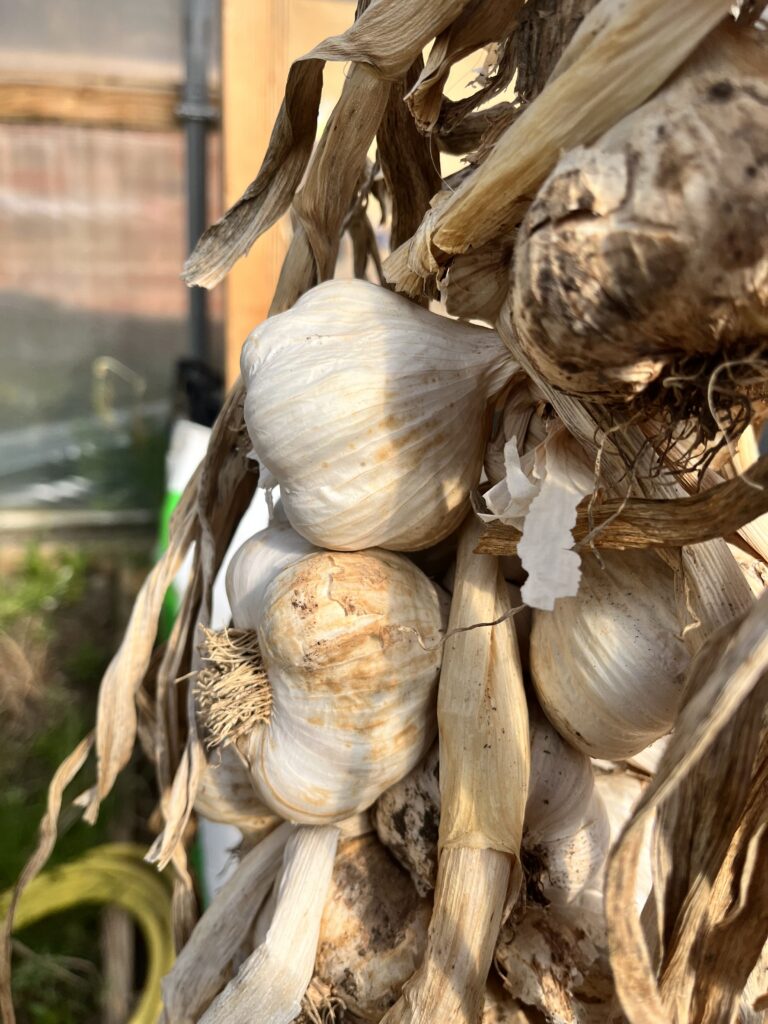
Recommended Varieties
There are a lot of different types of garlic on the market and what you buy will depend on your climate and preference for intensity of flavour. Here are some of the more popular varieties:
- Christo – a softneck variety that is a reliable cropper, growing well whether planted in the autumn or spring, It stores well and produces large bulbs. It does not like heavy, waterlogged soil. The flavour is intense but subtle. This cultivar has received the RHS Award of Garden Merit (AGM).
- Early Purple Wight – a softneck variety that matures early in the season, typically from May in warmer areas through to the middle of June in cooler areas. This variety does not store very well and will have to be used within a couple of months, so unless you use a lot of garlic, don’t plant too much of this type. It is planted in autumn to early winter.
- Germidour – a reliable softneck garlic that tolerates damp conditions, even when planted in the autumn, that stores very well. The flavour is mild and great for cooking but is particularly good when roasted whole. This cultivar has received an Award of Garden Merit (AGM) from the RHS.
- Iberian White – a good softneck variety producing large bulbs with a medium-strength garlic flavour that does not overpower flavours when used in cooking.
- Lautrec Wight – a strong-flavoured, hardneck garlic that prefers a warmer climate and does not like waterlogged soil. It is planted in the autumn but will do well when planted in the spring.
- Picardy Wight – a softneck aridity that has a strong, full flavour and is suitable for most parts of the UK and grows well when planted in the spring. It typically matures around July and stores well until the following April normally.
- Solent Wight – one of the most popular softneck cultivars in the UK, it performs well when planted in the autumn or spring. It matures slightly later than other cultivars and has a full garlic flavour.
Growing Tips
Squirrels and birds love pulling garlic cloves up from the ground and after planting you can often find some of the cloves sitting on the surface of the soil. If this happens, just push them back into the soil and they will be fine once they have rooted. If this is a recurring problem, you can cover the garlic until it has rooted or start the cloves off under glass in modules.
Avoid planting garlic too close as this encourages fungal diseases such as rust, which can cause problems with your crop maturing.
